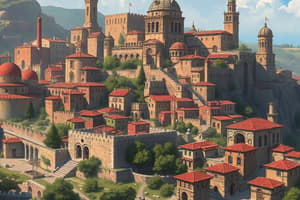Podcast
Questions and Answers
מהו המאפיין המרכזי של אדריכלות רומנסקית וגותית?
מהו המאפיין המרכזי של אדריכלות רומנסקית וגותית?
- עיצוב אורגני
- תבנית רשת
- שימוש באבן, קשתות ותקרות (correct)
- שימוש בחומרי בנייה מסורתיים
מהו המרכיב המרכזי של עיירות הטירה?
מהו המרכיב המרכזי של עיירות הטירה?
- מבנה רומנסקי
- בניין גותי
- מרכז כוח פיאודלי (correct)
- תבנית רשת
מהי התכונה המאפיינת של התכנון העירוני בעיירות איטלקיות?
מהי התכונה המאפיינת של התכנון העירוני בעיירות איטלקיות?
- מבנה גותי
- תבנית אורגנית
- מבנה רומנסקי
- תבנית רשת (correct)
מהו המבנה החברתי שמאפיין את עיירות ימי הביניים?
מהו המבנה החברתי שמאפיין את עיירות ימי הביניים?
מהו המניע המרכזי לצמיחה ופיתוח בעיירות ימי הביניים?
מהו המניע המרכזי לצמיחה ופיתוח בעיירות ימי הביניים?
מהו הגורם העיקרי שהוביל להתפתחות העירונית בימי הביניים?
מהו הגורם העיקרי שהוביל להתפתחות העירונית בימי הביניים?
מהו התכונה הבולטת ביותר של הערים הבישופיות?
מהו התכונה הבולטת ביותר של הערים הבישופיות?
מה היה התפקיד העיקרי של הגילדות בכלכלה העירונית בימי הביניים?
מה היה התפקיד העיקרי של הגילדות בכלכלה העירונית בימי הביניים?
מה היה התכונה המרכזית של הרחובות בערים הימי-ביניימיות?
מה היה התכונה המרכזית של הרחובות בערים הימי-ביניימיות?
מהו המאפיין העיקרי של הערים המרכנאיות?
מהו המאפיין העיקרי של הערים המרכנאיות?
מהו המטרה העיקרית של החומות שהקיפו את הערים הימי-ביניימיות?
מהו המטרה העיקרית של החומות שהקיפו את הערים הימי-ביניימיות?
Flashcards are hidden until you start studying
Study Notes
Overview of Urban Development in the Middle Ages
- The Middle Ages, roughly spanning from the 5th to the 15th century, saw significant urban development in Europe.
- During this period, towns and cities emerged as centers of trade, commerce, and industry.
Factors Influencing Urban Development
- Trade and Commerce: The growth of trade and commerce led to the establishment of new towns and cities, particularly along trade routes.
- Agricultural Surplus: Increased agricultural productivity and surplus led to the growth of a non-agrarian population, which fueled urbanization.
- Feudalism: The feudal system, with its network of lords, vassals, and serfs, contributed to the development of towns and cities as centers of power and administration.
Characteristics of Medieval Towns
- Walled Cities: Many medieval towns were surrounded by walls for defense and protection.
- Narrow Streets and Alleys: Streets were often narrow and winding, with closely packed buildings and limited sanitation.
- Marketplaces: Towns typically had a central marketplace where goods were sold and traded.
- GUILDs: Guilds, associations of craftsmen and merchants, played a significant role in medieval urban economy.
Types of Medieval Towns
- Bishop's Towns: Centers of ecclesiastical power, often with a cathedral or monastery.
- Merchant Towns: Focused on trade and commerce, often with a strong guild presence.
- Castle Towns: Developed around a castle or fortress, often serving as a center of feudal power.
Urban Planning and Architecture
- Grid Pattern: Some medieval towns, such as those in Italy, were built with a grid pattern, while others, like those in Germany, were more organic in design.
- Romanesque and Gothic Architecture: Characterized by the use of stone, arches, and vaults, with the development of Gothic architecture marking a significant shift towards more elaborate and ornate buildings.
Social and Economic Structure
- Social Hierarchy: Medieval towns were characterized by a strict social hierarchy, with the wealthy and powerful at the top and the poor and marginalized at the bottom.
- Economic Activities: Towns were centers of economic activity, with trade, commerce, and industry driving growth and development.
Studying That Suits You
Use AI to generate personalized quizzes and flashcards to suit your learning preferences.




